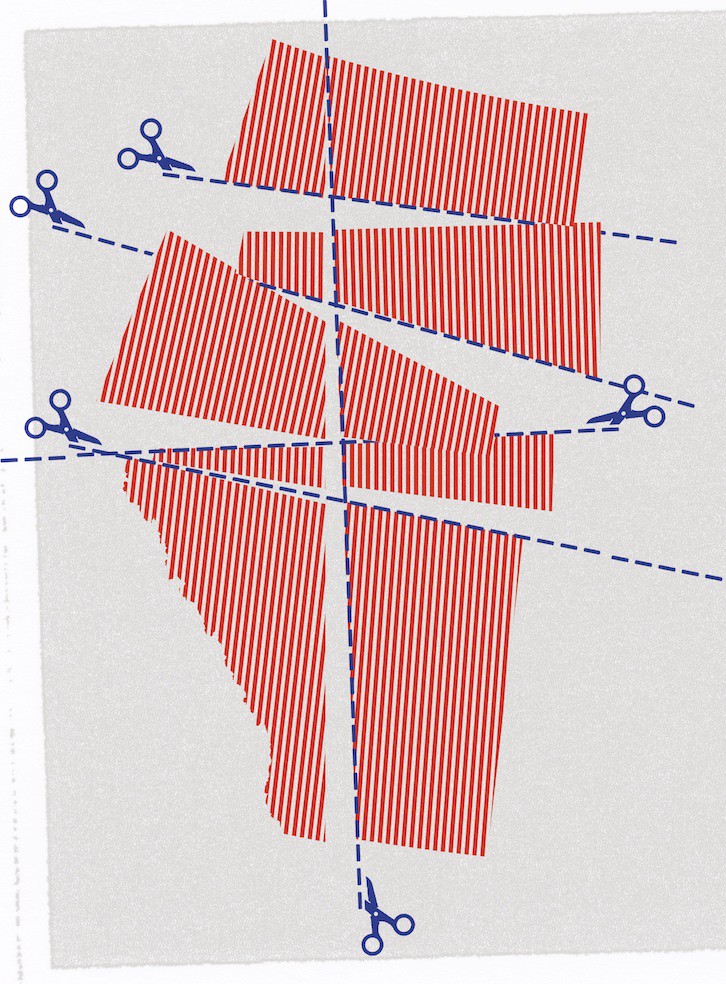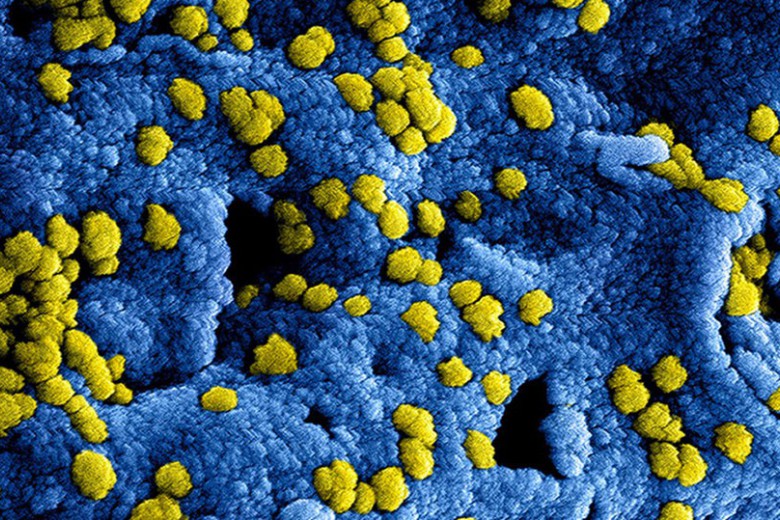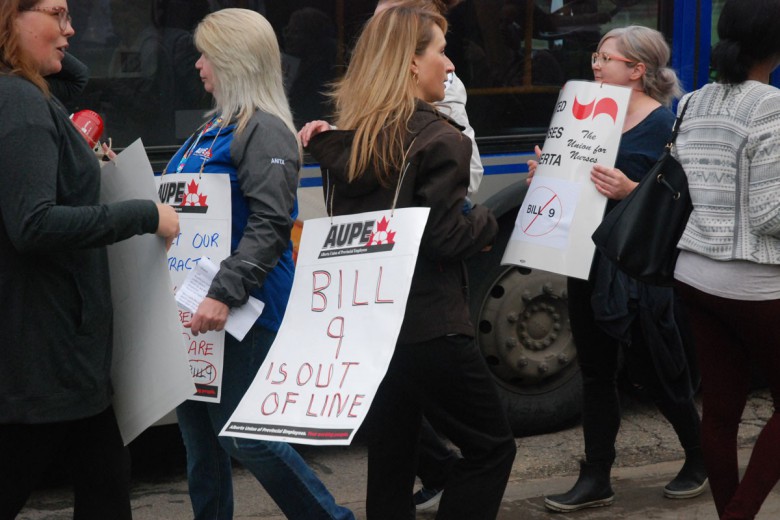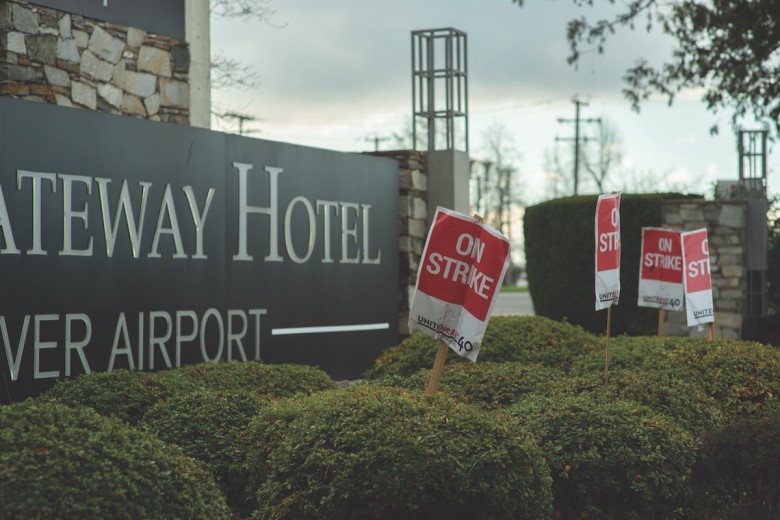
Amanda Priebe
Soon after Jason Kenney was elected Alberta premier in the April 2019 landslide victory for his United Conservative Party (UCP), he moved hard and fast to begin rolling back the tepid labour reforms of his New Democrat predecessor. In doing so, Kenney built a framework for austerity that is ripe for exploitation by his successor, Danielle Smith, who – throughout her career straddling the worlds of media, politics, and corporate lobbying – has made no secret of her anti-labour animus.
But by laying this approach bare for all to see, Kenney gave his opponents a clear sense of what they’re up against, inadvertently providing organized labour the opportunity to tailor its response accordingly.
There was a logic to the velocity with which Kenney acted to reverse the NDP’s labour legacy. “Speed creates its own momentum. It also makes it harder for the opponents of reform to obstruct it,” he told a sympathetic audience at the Calgary Chamber of Commerce in October 2018. This rapid-fire approach allowed Kenney to continuously stay one step ahead of his opponents as he implemented his agenda. By the time the labour movement could organize around one particular policy through established channels, Kenney was on to the next.
In his early days as premier, Kenney passed a series of laws that fattened the private sector while trimming the public sector to the bone. He cut taxes and then used the deficit he’d exacerbated as pretext for his long-term goal – dating back to his years as president of the Canadian Taxpayers Federation – of privatizing services.
Kenney’s policies had nothing to do with creating jobs but everything to do with reducing burdens on the capitalist class.
A major impediment to that ambition has always been public-sector unions, which he regarded as an enemy to be vanquished on the path to private prosperity. Beyond rewarding the private sector, he placed increasingly onerous restrictions on organized labour.
University of Alberta political scientist Jared Wesley has referred to Kenney’s “prosperity-first” mentality, which prioritizes private profit over all other considerations. This fundamentally neoliberal disposition permeated his approach to all aspects of governance, from the oil and gas industry to public education, health care, and the drug poisoning crisis. Premier Smith hasn’t departed from this basic framework in the slightest.
The Alberta Union of Provincial Employees (AUPE), which represents over 95,000 public-sector workers provincewide, is Alberta’s largest union. Its president, Guy Smith (no relation to the premier), says it would be a mischaracterization to say he had a bad relationship with Kenney. “Kenney did not interact at all. There was actually no relationship whatsoever,” says Smith.
Negotiating with any government is an inherent challenge for a public-sector union, Smith says. He characterizes Dave Hancock – who served as interim premier for six months in 2014 to clean up the mess his scandal-plagued predecessor, Alison Redford, left behind – as “great to work with.” Hancock’s successor, former federal Conservative MP Jim Prentice, was also highly engaged.
Rachel Notley, however, who was a labour lawyer before entering politics and whose husband, Lou Arab, works as a communications officer for CUPE Alberta, took organized labour for granted, Smith says. Under Notley’s premiership, the union accepted two years of wage freezes in exchange for arbitration in year three. “Although we got some really good language changes in our collective agreements, there was absolutely no money there. We actually got more raises with the [UCP] government than we did with the Notley government,” says Smith. Notley didn’t even meet with him until the third year of her mandate, which he describes as “absolutely bizarre.”
One way in which Kenney departed from his predecessors was in using the strong arm of the law to pressure the labour movement, a trend Danielle Smith has continued. “But at the end of the day, we’re going to set our own course regardless of legal restrictions. That’s not going to deter us from doing what we need to do on behalf of our members,” Guy Smith says.
Kenney built a framework for austerity that is ripe for exploitation by his successor, Danielle Smith.
Kenney’s first order of business, as promised repeatedly on the campaign trail, was to eliminate the NDP’s dreaded carbon tax by the end of May 2019. “Promise made, promise kept,” he said, in what would become a familiar refrain. Kenney’s elimination of the $30 per tonne NDP carbon tax meant that the federal Liberals’ carbon tax would take its place.
But this ostensibly symbolic gesture served two important purposes for Kenney. It allowed him to present himself as standing up to federal government overreach while reducing provincial revenues by $1.3 billion, giving him pretext for downsizing the state. The carbon tax cut, however, was small potatoes compared to what was to come.
For his second piece of legislation, Kenney introduced a suite of employer-friendly labour reforms, opening up his first salvo against the labour movement with the Open for Business Act. A key component of the legislation was partially reversing the NDP’s increase of the minimum wage to $15 an hour from $10.20 an hour, which former premier Rachel Notley cautiously phased in from 2015 to 2018.
It would have been politically costly for Kenney to outright reduce the minimum wage, so he created a second-tiered wage for youth of $13 an hour. “$13 an hour is a heck of a lot more than $0 an hour, and that’s the option here. We’re talking about part-time, teenagers who are typically in high school, working typically 20 hours a week or less,” he explained at a May 27, 2019, press conference.
The legislation also reversed the NDP’s 2017 introduction of automatic union certification, or card check, which mandated the formation of a union if 65 per cent of a bargaining unit’s membership signed membership cards, leading to more than a doubling of union certifications the year it was introduced. Forcing union elections on workers, which Kenney naturally presented as a victory for workplace democracy, bought employers time to interfere in the certification process.
Job creation tax cut eliminated jobs
The centrepiece of Kenney’s pro-corporate, anti-labour salvo in the early days of his premiership was the so-called Job Creation Tax Cut, which sought to slash Alberta’s corporate tax rate from 12 per cent to 8 per cent over four years, bringing it two percentage points lower than it had been before the NDP came to power. Under the guise of pandemic recovery, Kenney reduced the rate to 8 per cent in July 2020 – 18 months ahead of schedule.
The corporate tax cut placed great strain on Alberta’s finances, which was by design. The NDP Opposition repeatedly pegged the cost of this corporate largesse at $4.5 billion, which proved to be a major underestimate. Alberta’s five largest energy companies alone, PressProgress reported in November 2019, announced a combined $4.277 billion in savings in their quarterly reports to shareholders.
It would be one thing if this generosity toward the province’s biggest oil companies resulted in an increase in jobs. After all, Kenney’s 2019 campaign slogan was, “Jobs, Economy, Pipelines.” But that wasn’t what happened. Instead, according to a September 2022 study from the University of Alberta’s Parkland Institute, these savings went toward eliminating workers’ jobs through automation and increasing executive and shareholder compensation.
Kenney’s “prosperity-first” mentality prioritizes private profit over all other considerations.
The job creation also failed to materialize in other sectors. Writing in October 2022, independent journalist Kim Siever found that the number of jobs created in the three years after the tax cut was introduced didn’t keep up with population growth. The province added 83,600 jobs between June 2019 and September 2022 – a 3.65 per cent increase – while the working-age population grew by 5.43 per cent. Nearly half of those new jobs were part time, suggesting a growing precarity in the form of work available.
The neoliberal nostrum that tax cuts necessarily lead to job creation doesn’t add up, since corporations have a fiduciary duty to their shareholders, not their workers. “[N]o one is going to hire more workers just because they have more money on hand, unless demand was already increasing for their products and services” and they needed more workers to keep up with that demand, Siever wrote.
Kenney’s policies had nothing to do with creating jobs but everything to do with reducing burdens on the capitalist class, which continued with his Red Tape Reduction Act. Kenney promised to cut red tape for business by one-third and prevent it from “creeping back,” which he insisted would make Alberta the “freest economy in Canada,” although it’s unclear how one measures red tape, let alone freedom. But, as we shall see, reducing regulatory burden was a luxury only afforded to the ruling class.
When it came to the working class, Kenney sought to actively increase the regulatory burden imposed on them. In July 2020, Kenney introduced Bill 32, or the Restoring Balance in Alberta Workplaces Act, based on the faulty premise that the NDP had tilted the scales of labour relations too far in employees’ direction. The legislation placed onerous restrictions on how unions could operate in the province in two major ways – by restricting how they strike as well as how they spend members’ dues.
The legislation prohibits striking unions from picketing at secondary work sites – those that are not the employees’ workplace but are connected to their jobs, whether it’s another business owned by their employer or another business that indirectly depends upon their labour – without express approval from the Alberta Labour Relations Board. If an employer decides to hire scabs, striking workers are prohibited from blocking their entrance to their work site.
Bill 32 also created an artificial divide between core union functions, such as collective bargaining and grievance settlement, and “political activities,” with workers required to explicitly opt in to paying dues toward the latter. By then-Minister of Labour and Immigration Jason Copping’s own admission, this created added “red tape” for unions, who were forced to calculate how much of their dues went toward core and “political” activities.
What sorts of political activities did Kenney have in mind? In a July 13, 2020, tweet, he cited unions signing the 2016 Leap Manifesto, which called for the immediate start of a transition to a clean energy economy, expressing opposition to U.S.-led efforts to oust the socialist Venezuelan government, and inviting famed environmentalists Tzeporah Berman and David Suzuki to speak to members as examples of “union boss political activities.”
The labour movement cannot take a piecemeal approach to fighting this far-reaching agenda.
Never mind that all these examples would have been voted on by union membership democratically. The purpose was to starve unions of funding that they could use to fight back against the neoliberal agenda Kenney embodied, whether at home or abroad. And it worked, but not in the way Kenney likely had in mind.
The legislation was finally implemented in August 2022 – the dying days of Kenney’s premiership. As a result, unions reduced their charitable contributions to community groups by 38 per cent, or $2.5 million, compared to before the act went into effect, according to a Parkland Institute study written by its director, Jason Foster.
The United Conservative Party (UCP) view that unions are “these big bad entities that get in the way of prosperity,” he told me, blinded it to the range of activities unions engage in outside the collective bargaining process. “In their rush to try and stick it to the unions, they didn’t pause long enough to realize that this has negative consequences for groups other than unions,” Foster said.
Once the legislation went into effect, Building Trades of Alberta launched a Charter challenge against it, with CUPE Alberta joining them in a separate court case late in the year. In July 2023, the government said it was reviewing the opt-in dues provision, but as of writing it has made no change. The slow pace of court proceedings is no match for the speed with which the government acted to tilt the scales of labour relations even more heavily in employers’ direction, suggesting the impropriety of using it as the main terrain for fighting the UCP’s corporate agenda.
Danielle Smith tries to smooth the edges of the same agenda
Kenney’s downfall ultimately had nothing to do with his approach to organized labour. If anything, these policies enabled him to keep his fractured caucus unified before it was torn apart by dissent from those who thought he should have never imposed any COVID-19 restrictions at all and wanted to see an escalation in his war of words with Ottawa. In came Danielle Smith, who was elected UCP leader in October 2022, promising to be everything Kenney wasn’t when it came to pandemic mitigation measures, which she opposed, and taking action to seal Alberta off from the rest of Canada, which she supported.
Smith – who, months into her career as an op-ed columnist at the Calgary Herald, scabbed while the paper’s journalists went on strike in 1999 and 2000 – has never made a secret of her distaste for organized labour. As recently as May 2022, the dyed-in-the-wool libertarian ideologue advocated the creation of privately operated but publicly funded charter hospitals, modelled after the charter schools she was such an enthusiastic proponent of when she sat on the Calgary Board of Education in 1998 and 1999.
She said this would give health-care workers a choice about whether they want to work in a unionized hospital or not. “I have a lot of sympathy for those who want to work in a hospital, and do surgical services and care, [where] one work site is no better than the next,” she said in a May 27, 2022 livestream on her since-shuttered private Locals.com social media page. “That’s what we’ve got to remedy.”
Once re-elected, Danielle Smith carved Alberta Health Services it into separate organizations for primary care, acute care, continuing care, and mental health and addictions, allowing her to sell off each component for parts.
Smith didn’t take an axe to the public sector in the same fashion as Kenney in her first budget in February 2023. The price of oil, to which Alberta’s budgetary fortunes have long been tied, was high, and she had a re-election campaign coming up in May.
Once securely re-elected, however, Smith embraced some of her more radical instincts, chief among them her plan to dismantle Alberta Health Services (AHS), the arm’s-length body that delivers health care throughout the province, carving it into separate organizations for primary care, acute care, continuing care, and mental health and addictions, allowing her to sell off each component for parts.
Heather Smith (no relation to the premier or AUPE president), who has been president of the United Nurses of Alberta (UNA) since 1988, has dealt with nine premiers, from Don Getty to Danielle Smith. While she had her ups and downs with all of them, she says Kenney took a much more belligerent attitude toward organized labour than his predecessors. While Ralph Klein’s wholehearted embrace of the austerity craze of the 1990s led to tense relations with nurses, Heather Smith felt that he could be moved. Kenney, however, is a true believer in the neoliberal gospel.
Danielle Smith represents “an even greater threat than Kenney,” in terms of her contempt for organized labour and public health care.
Heather Smith says there was “nothing [like] the kind of contempt and disdain that we felt in the first four years of the UCP mandate.” Smith never once met Kenney, nor did she interact directly with his initial health minister, Tyler Shandro, even before the pandemic precluded in-person meetings. “It was horrible because we were in the pandemic and we had a health minister and a premier that had, from my perspective, no respect for not just nurses, [but] any health-care worker [in] our public health care system,” she explains.
Danielle Smith represents “an even greater threat than Kenney,” in terms of her contempt for organized labour and public health care, not to mention her embrace of quack COVID remedies like ivermectin and hydroxychloroquine and anti-vaccine sentiments. “I think she has even greater disrespect for organized labour, if that’s possible,” says Heather Smith.
But at least with Kenney, the public knew where he stood in relation to organized labour. Danielle Smith, however, has proved more “manipulative.” Heather Smith says the premier, prior to the May election, showed up uninvited to a meeting UNA had with Jason Copping – who replaced Shandro as health minister in September 2021 – to ask if the nurses’ union would be interested in participating in government town halls on health care.
This crisis in health care is occurring “against this backdrop of conservative ideology that wants to push for more privatization where you pay more and get less” and cannot be regarded in isolation from it.
Heather Smith says the premier used her appearance to communicate that she’s engaging with the labour movement she despises. “You don’t do that. You don’t creep into meetings,” says Heather Smith. But since the election, the gloves have come off.
On December 1, a few weeks after Premier Smith announced her plans to dismantle Alberta’s public health-care system as we know it, AHS sent a letter to UNA informing them that “there will be some reductions in positions within UNA’s AHS bargaining unit flowing from the movement of functions outside of the organization.”
David Harrigan, Heather Smith’s UNA colleague, told CBC News that the letter is typical government “sabre-rattling” that occurs in advance of negotiations, which began in February. However, he expressed concern that the uncertainty created by AHS’s dismemberment, of which the letter is a testament, will make it impossible to address the province’s very real shortage of health-care workers. “It’s only going to worsen the problems that already exist,” he said.
But the wide-ranging nature of the threat organized labour faces from a dyed-in-the-wool ideologue like Danielle Smith requires a wide-ranging response. Unions can ill afford to focus on how UCP policies impact their members alone, nor can they afford to depend solely on costly, time-consuming court battles.
Danielle Smith’s actions, particularly as they pertain to dismantling AHS, wield the prospect of accelerated austerity over the heads of public-sector workers.
UNA’s Smith says retention of nursing staff is the main focus of the union’s advocacy efforts, with its “three-R” campaign of “Respect, Retain and Recruit” to “dig ourselves out of this hole.” UNA is working with like-minded allies, including advocacy groups Friends of Medicare and Public Interest Alberta, as well as the Canadian Federation of Nurses Unions, the Alberta Federation of Labour and the Canadian Labour Congress.
This all-hands-on-deck approach is a must, “because of the desperation that is happening every day in facilities and in community services right across this province, simply not having enough people to come close to meeting needs, and in many cases, creating very unsafe situations for patients and staff.” Since UNA alone doesn’t have the resources to fight against a government with a $5.5-billion budget surplus, it needs all the support it can get.
This crisis in health care, Heather Smith says, is occurring “against this backdrop of conservative ideology that wants to push for more privatization where you pay more and get less” and cannot be regarded in isolation from it.
“We’re dealing with a philosophy of austerity here that we have to fight back against.”
Nor is it a recent phenomenon. Since he assumed the AUPE presidency in 2008, Guy Smith says he’s faced the same key issue repeatedly, regardless of who’s in power, which is the continuous erosion of the public sector, whether it’s in health care, post-secondary education, or government services, leading to demand for services outpacing staffing levels, forcing public-sector workers to do more with fewer resources.
But Danielle Smith’s actions, particularly as they pertain to dismantling AHS, wield the prospect of accelerated austerity over the heads of public-sector workers during negotiations that are underway. As a result, Guy Smith says he’s prepared an unprecedented degree of coordination among AUPE locals, with an emphasis on securing pay increases, job security, and increased staffing for all members.
“We’re dealing with a philosophy of austerity here that we have to fight back against.”
The labour movement cannot take a piecemeal approach to fighting this far-reaching agenda. There must be a united front that builds a collective consciousness and vocabulary about the UCP’s endgame – for workers to be subjected to the whims of their bosses, who treat them as units for generating profit. Winning a court challenge here and having the NDP commit to certain labour-friendly policies there isn’t going to cut it.






